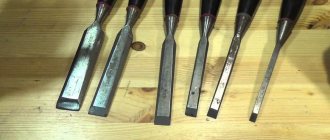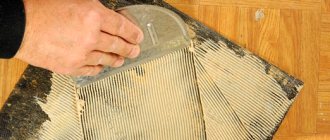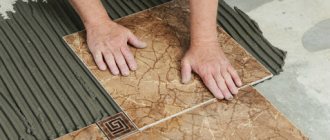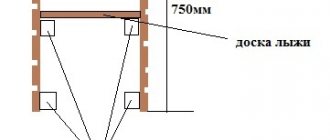Almost every person who likes to repair or build something with their own hands sometimes needs to rack their brains over how to properly connect two objects or materials. Linoleum and tile are the two most popular types of flooring. After renovation, every person wants the house to be comfortable, beautiful and safe, so many people design a corridor or a passage between rooms without a threshold at the junction of linoleum and tiles.
We combine different materials
Many people separate tile and linoleum because they are tired of dirt and dust. Most often, the place where the two materials meet is the kitchen. Linoleum and tiles allow you to highlight functional areas - dining and cooking areas.
Tiles are usually laid on the dining area, and linoleum on the hob. It is much more pleasant to move on it, since it is much softer and does not slide as much. The line dividing these two coatings is too large, therefore, to make a high-quality and safe transition, overlays are used. Also, tiles are laid in the corridor, because most of the dirt from the entrance gets there. Due to the fact that the joint line between the rooms is shorter, the two canvases can be joined with profiles.
Is linoleum intended for a concrete or wood base?
Linoleum can be laid on concrete. However, this is only if there are no depressions, bumps or noticeable differences in height on the base. All this then begins to protrude, to avoid which you need to level the floor before laying the covering on it. Self-leveling products are most suitable here, thanks to which unevenness is smoothed out well. If necessary, you can repeat the concrete screed.
Linoleum can also be laid on a flat plank floor. Even such a base, if it is very dry and there are no pathogenic microorganisms in it, will not rot. But only if the linoleum is laid correctly and the floor underneath is then ventilated.
When fastening with hardware, you must ensure that their heads do not protrude above the surface, otherwise the finish will gradually be worn away by them. The caps must be coated with silicone sealant. You also need to ensure that the covering sheets are carefully connected and glued together.
Linoleum can be laid on both a concrete and wooden base, if it is smooth and does not have severe defects
For greater safety, you can additionally treat the coating with bactericidal preparations. If linoleum is laid correctly, water will never seep through it, which can cause great harm later. To avoid damage by water, you can use wide baseboards, which must be carefully pressed, and also treat the joints with sealing tape.
When laying linoleum, a backing made of insulating material is often used. It is optional, but it can even out minor unevenness and also absorb noise. If you have a cold basement, it is definitely better to lay a base: it will help retain heat.
Here are the most popular materials for linoleum backing:
- jute;
- cork (crushed material goes onto the substrate);
- foamed polyethylene.
Substrates are often laid under linoleum to even out minor unevenness.
Composite materials are often used as substrates.
As for extruded polystyrene foam, this is a bad material for a substrate: sheets about a couple of centimeters thick will greatly soften the coating, which will make walking on it unpleasant and uncomfortable. Synthetics with a persistent pungent odor are generally unsuitable for such a purpose, since this directly indicates a defective product that cannot be used if your health is important.
About linoleum substrates
Tips from a pro
In the kitchen, it is important that the tiles are at the same level as the linoleum, so it will be convenient to remove debris that falls on the floor during cooking. In the corridor the situation is completely different. In order to retain heat, the entrance is lined with linoleum, and immediately after it, the so-called “sanitary” part is laid out. This part is covered with tiles, and most of the dirt accumulates on it.
You can make the transition from tiled flooring to linoleum in the following ways.
- Metal thresholds . This design can be used in the corridor or on the floor, under the door, since its width is no more than 50 mm, the difference in height will be no more than 16 mm.
- Phishing corners . This option is suitable if the tile level needs to be made higher than the linoleum level.
- Folk method . If the previous options do not work, then you can seal the seam using a wooden bead. To do this, you need to screw the plank to the linoleum using thin self-tapping screws, without glue. And glue the bead itself to the end of the tile, but the lower edge, which is adjacent to the linoleum, must be filled with silicone. To close the gap, you can take an aluminum profile and attach it to a sliding fastener. If the apartment has a floor heating system, then this becomes most important, since this connection scheme is more flexible and easily adapts to height fluctuations.
Preparation for joining laminate flooring
Let us remind you that to lay laminated panels, the base must be well prepared, leveled and cleaned of all contaminants. For joining two floor materials, this condition is also mandatory.
To join laminate to laminate, you need to assume that the panels can have different thicknesses, it is 6 - 12 mm. The best way is to purchase laminated boards and a backing of the same thickness in order to avoid the slightest difference in the height of the surfaces. It is very good if materials from the same manufacturer are to be joined, so that they have the same type of locking connections, the same strength class, and therefore service life.
How to join laminate to laminate, with or without threshold, and what profile should be used to join the laminate?
There are several options for joining laminate to laminate. Let's look at the most common and less complex ones.
Most often, the connection of laminated surfaces occurs during the transition from one room to another, i.e. in a doorway. It is imperative to leave a technological gap here. In its absence, the formation of deformation and swelling of the floor surface is likely. The gap left must be filled in somehow. How to seal laminate joints?
Laminate joint in a doorway
To our joy, all these questions have been thought out for a long time, the answers to them have long existed, our task is to take ready-made solutions and apply them correctly. Coating manufacturers also produce a variety of components. These include: substrates, baseboards, connecting strips for laminate. The connection strips are also called thresholds, moldings, connection profiles. They vary in shape and are made from different materials.
Profile form
According to their shapes, the joining strips for laminate can be divided as follows:
The products considered are decorative, but not only. When installing a laminated floor, a technological gap is required, which the connecting profiles make hidden, protect from damage and at the same time allow for an aesthetic appearance.
Threshold materials
Connecting profiles are made from various materials.
- Laminated - made from compressed wood fibers, with a laminated film with decoration applied on top. There is a wide variety of colors and textures, so it is not difficult to match the decor of the joining laminate. The connection looks aesthetically pleasing and, if selected correctly, is almost invisible. Often installed at the junction of a doorway.
- Metal - aluminum, brass, steel; The top is covered with a decorative film. It is characterized by high strength, thanks to which it is installed in places with high traffic, for example: doorways.
- PVC profile is a flexible joining profile for laminate flooring, excellent for making wavy joints. Available in a wide variety of colors, i.e. well matched to the color of the joining surface. It is relatively inexpensive.
- Rubber - often an angular profile for decorating staircase steps. They are anti-slip and increase the safety of walking on steps.
There are several known ways to design a joint line:
- using thresholds, profiles;
- use of cork compensator;
- use of construction sealants.
With all its advantages:
- ease of installation;
- beautiful view of the joint;
- no threshold - not used too often.
The point is their serious shortcomings:
- after their use, it is impossible to dismantle panels in contact with the connecting compound without damage;
- When filling a joint with sealant or foam, the laminate loses the ability to expand, this can lead to damage to the coating.
Threshold and profile: we make the connection
To close the seam line, you need to lay the edge of the linoleum with a flexible and durable adhesive. Rubber, epoxy and other adhesives will not work. In this situation, sealant, which can be purchased at any plumbing store, will help out.
The sealant is a very durable material, and after hardening it will hold the linoleum no worse than “liquid” nails, it also does not shrink, and at the same time, there will be no cracks. This material easily withstands the effects of detergents, dust and hot water.
However, if you need to glue two flexible materials, you can use any glue. But, if one of the materials is glass, ceramics or tiles, then only sealant should be used.
First you need to trim the linoleum a little, and after that, apply silicone along the joint and lay the canvas on it. Next, in increments of 100-200 mm, drill holes for the dowels and hammer plastic bushings into them.
To install the profile, you need to align the fasteners so that all the dowels are above their place. Now all that remains is to place the threshold on the dowels and use a mallet to drive it into place. The final stage is to load the pad with additional weight, so all the excess silicone will come out from under the threshold, sealing the seam between the tile and linoleum well.
How to glue linoleum at joints
To prevent the seam from coming apart in the future, you can secure it using an aluminum or plastic threshold. But this method is not suitable for many. Therefore, a chemical method comes to the rescue here - cold or hot welding. Let's take a closer look.
Cold welding
This is an adhesive polymer mixture that consists of almost the same components as PVC linoleum. Tetrahydrofuran or synthetic rubber compounds are used as a base. The mechanism of action is simple: upon contact with the flooring material, the adhesive composition reacts with it and slightly melts the edge. The result is that the edges are joined, the seam is almost invisible, waterproof and durable.
The material works on natural and PVC linoleum of all types - from household to commercial. Most often the product is used for work in residential areas.
Of particular importance is the composition of the material - homogeneous or multilayer. The type of adhesive mixture used depends on this. Such giants as Forbo, Tarkett, Werner Müller produce the following types of cold welding:
- Type A – transparent adhesive for gluing seams of PVC coverings, homogeneous or heterogeneous, on a foam base. The joint must be tightly cut, that is, obtained as a result of trimming the edges of overlapping sheets. It is applied with a special needle built into the tube cap;
Cold welding type A.
- Type T – paste for gluing joints of linoleum on a polyester and combined (PVVC + PE) basis. Synthetic felt does not have high density and uniformity, so a “stronger” and thicker compound is needed. To introduce glue into the seam, use a needle or a nozzle with a T-shaped nozzle.
Cold welding type T.
- Type C is a thick repair composition that allows you not only to glue seams with a gap of 0.3 to 4 mm, but also to fill the space with a transparent waterproof mixture. Inserted into the joint using a C-shaped nozzle. You can also use this glue for various PVC profiles, gluing wallpaper, strengthening carpet loops, repairing leatherette upholstery and much more.
Cold welding type C.
Products processed by cold welding can be used in the temperature range from -40 ºС to +60 ºС. Any variety is slightly toxic and flammable, so you need to protect it from fire, heat, and use personal protective equipment (gloves, goggles, respirator) when working.
Hot welding
This term denotes a process, the essence of which is the following: a welding cord of a color suitable for PVC or natural marmoleum is tucked into a special nozzle for a hair dryer, melted in it and applied to the area where the linoleum is being glued. The excess is cut off, and the seam is strong, resistant to deformation and stress.
Welding cords are made from complex polymer compounds with the addition of pigments. Since the product is produced in a wide range of decors, the manufacturer’s range of styling accessories includes at least 100 shades. If you wish, you can order your own shade, but the execution time is not short - up to 3 months.
Bonding technology using a welding cord is recommended for all linoleum products in rolls and tiles. Because specific tools and equipment are required, this method is most often used by teams of professional installers on commercial homogeneous and heterogeneous pavements that are laid over large areas.
Application of cold welding
You will need:
- Adhesive for gluing “cold welding” seams of the type suitable for your material. For natural and polyvinyl chloride homogeneous and heterogeneous coatings this is category A or C (for wide gaps), for felt-based products - series T.
- A construction knife, a roller cutter or a special edge trimmer.
- Metal ruler or guide.
- Paper (painting) adhesive tape, double-sided tape (for gluing the sliding cut to the base).
- Soft cloth to remove dust.
- Construction hair dryer for heating hard linoleum (semi-commercial or commercial)
- Rubber roller for rolling seams or cork block.
Tools for working with cold welding.
The surface under the linoleum should be clean, free of dust and foreign debris. The coating should also be thoroughly wiped, removing dust and greasy marks. According to the manufacturers' recommendations, the flooring material is first glued over the entire area; after a day, the edges of the canvas can be processed.
First of all, you need to get a so-called tightly cut seam, that is, an absolutely even and well-fitting joint. To do this, the edges of the linoleum pieces are overlapped (from 3 to 5 cm). The strips are pressed with a steel ruler or strip and both sheets are cut simultaneously with a sharp knife or a special cutter. The trimmings are removed.
If necessary, one of the linoleum sections is fixed to the base using double-sided tape. If you are afraid of damaging the top protective layer, then you can glue paper adhesive tape to the edges before trimming, and after work, remove the remains along with the trimmings.
Scheme of working with cold welding glue.
Now you can glue masking tape onto the resulting tightly cut seam. It will protect the linoleum from excess glue, but it is necessary to seal the joint by rolling the tape with a rubber roller. You need to carefully make a cut in the middle with a knife and heat the coating a little with a hairdryer. Next, put a needle attachment on the tube, insert it into the cut and carefully squeeze out the glue, gradually moving along the seam. After 10-30 minutes (according to the instructions on the package), you can remove the paper tape
When working with type C cold welding, the joint area must be cleared of debris, glue residues, etc. Place a nozzle with a flattened nozzle on the tube and slowly fill the seam with transparent glue with a small margin (adhesive compounds shrink up to 75%). Allow to dry for 2-24 hours depending on the width of the gap. If necessary, repeat the process by applying glue over the old one.
It is not advisable to fill gaps of 4 mm or wider with two parallel or more seams. It is better to glue a strip of linoleum.
Method with metal edges
In this scheme, it is not necessary to use metal pads, as they are needed to simplify cleaning. It prevents water and dust from getting under the tiles.
The method involves the use of two metal edges. The execution process is as follows:
- Trim the linoleum so that the overlap on the surface of the tile is 4-10mm.
- Glue the linoleum so that its edge fits as tightly as possible to the end of the tile.
- Place a piping on the seam and a weight weighing up to 7 kg on it.
- After the glue hardens, using scissors or a saw, the crown is trimmed, and the seam that remains after this is filled with hot glue.
Visually, it does not look as good as with a threshold, therefore, most people lay a decorative strip on top, which, as practice has shown, very quickly falls off and is thrown away.
Basically, when making joints, a situation arises when cracks appear or poor adhesion of the material to the base or peeling of the plank. It all depends on the installation of the trim.
Possibility of installation on old flooring
Some people want to lay new linoleum on the old one. However, it is still recommended to remove the old coating. It's very hard sometimes and there's simply nowhere to go but leave it on the floor. But this cannot be done if the old linoleum is irreparably uneven.
The depressions should be filled with putty, the protrusions should be cut off, and the gaps between the facing tiles should be rubbed with a special agent. When preparing, you need to be careful and meticulously follow all the subtleties of surface treatment if you want the leveling to be successful.
In principle, it is possible to lay new linoleum even on an old coating - parquet, tiles or linoleum. Blisters, if present, should be pierced and then repaired with glue. Cracks are sealed, which is usually not a problem. The unpleasant side is the softness of the final surface, into which the legs of heavy furniture can go deeper.
You can put new linoleum on the old coating if it does not have pronounced defects and is fairly smooth
Before laying the finishing coating on boards or parquet, it is recommended to create a substrate by placing sheet material on it. Otherwise, the boards may bend, and this is clearly not beneficial for this coating. Here you can use plywood. But slabs made of wood chips swell from water, deforming the surface, making the finish much less attractive.
Joining at different heights
Well-known seam design options include a multi-level joint. The difficulty of its execution lies in the fact that it is difficult to find high-quality fasteners, and without it, if physical stress is applied to the lining, then over time it will become loose and can be easily pulled out with one hand.
To avoid this, you need to choose the right threshold with a vertical difference between linoleum and tiles of no more than 1.6 cm. In this situation, you will need to purchase a special step with two supports, which can be placed on both surfaces without any problems. Such models are mainly mounted on polyurethane foam.
Double-sided tape for joining panels
This method is the simplest and most cost-effective. To perform it, you do not need expensive materials or special equipment; you only need high-quality double-sided tape and accuracy. In order for the seam to be of the highest quality possible, the place where the panels are joined must be prepared: the base at the site of the future seam must be cleaned of dust and debris, and, if necessary, wiped.
After the base floor has dried, you need to carefully adjust the edges of the panels adjacent to each other so that they fit perfectly (for this you can use scissors or a construction knife). Then one side of the tape is glued to the floor surface along the marked seam line. There is no need to remove the protective coating on the top side yet.
Next, the panels are connected, gradually removing the protective coating from the adhesive layer of tape.
The method is very simple, but has disadvantages:
- such a connection of the canvases is not reliable - dust and debris will get into the seam, which over time will inevitably lead to the fact that its adhesive ability will decrease and the canvases will separate;
- the docking site cannot be made invisible;
- the seam is not sealed.
Therefore, this option is good for those rooms where it is planned to cover the linoleum with a carpet, and where water flow under it is unlikely.
Hot method of joining linoleum
Commercial linoleum is joined by hot welding. With this method, the seam is very clearly visible, but at the same time it is neat and strong. This method is used exclusively by specialists, as it is necessary to have a special, expensive tool.
The method is as follows: under the action of a special burner, the PVC filler cord melts, thereby filling the joint (more details: “How to connect linoleum together correctly”). All work is carried out at a temperature of 350-400°C. Thus, the cord and linoleum become soft and are additionally rolled with a pressure roller. After hardening, the excess cord is cut off with a chisel or a knife with an arched blade.
Docking methods
This problem will not affect only owners of small apartments where the rooms are not too large. For such rooms, you can easily choose linoleum, the width of which is greater than the size of the room, so you don’t have to worry about the beauty and strength of the seams - they simply won’t exist.
If the rooms are large, then one panel cannot be used - you will have to join them together. No matter how the linoleum was laid. You can’t just put two panels next to each other and leave everything as is. Sooner or later, at the joint, the linoleum will stretch out and become uneven. In addition, when wet cleaning, water will inevitably get under the coating, which will certainly affect the condition of the base of the floor, and even the linoleum itself. Therefore, joints must always be sealed in one way or another.
- Making a seam using a threshold. The method is simple, but you don’t want to see the threshold in the middle of the room. Plus, it's not so flat that you won't notice it. Therefore, this option is most suitable for decorating linoleum seams at the junction of two rooms. Here the narrow threshold looks quite natural.
- Fastening adjacent sheets using double-sided tape, which is glued on one side to the base of the floor, and on the other side to the back side of the linoleum sheets in the seam area. The method is simple and cheap, but does not guarantee the reliability, aesthetics of the seam or its tightness.
- Connecting the panels using hot welding. This option requires the use of special equipment and professional skills. Most often, hot welding is used for joints of hard commercial linoleum, which is extremely rarely laid in residential premises. And soft household-grade linoleum is easily damaged when exposed to high temperatures.
- Cold welding of linoleum. Special glue is used for it. In this case, no equipment is required - the can is made in such a way that it allows you to apply glue exactly to the right place.
Thus, the most accessible way for the average consumer to accurately and reliably join the edges of linoleum is cold welding.
If the rooms are large, then one panel will not be enough - you will have to join them together. No matter how the linoleum is laid, you cannot simply put two panels next to each other and leave everything as is. Sooner or later, at the joint, the linoleum will stretch out and become uneven. In addition, when wet cleaning, water will inevitably get under the coating, which will certainly affect the condition of the base of the floor, and even the linoleum itself. Therefore, joints must always be sealed in one way or another.
The joining method depends on the characteristics of the canvas:
- It is more reliable to connect the soft with a threshold;
- It’s better to put the hard one on glue.
If a soft covering is joined by gluing, the seam will become unusable in a short time. Commercial linoleum can be joined with a plank, but due to the large thickness of the material it does not always look aesthetically pleasing. The threshold is used at the junction of linoleum with other coatings (tiles, laminate). Also suitable for joining coatings with different patterns.
Results
If you want to lay linoleum, use the maximum width and do not create joints. If joints cannot be avoided, then there are 2 solutions:
- Buy glue, it is universal, and you can apply “cold welding” to the seams;
- Buy not linoleum, but carpet or laminate.
And one more recommendation: it is better not to roll the linoleum into an envelope - only into a roll, otherwise the linoleum may crack and it will be impossible to restore it.
Do you know how to properly mask linoleum seams? Share your experience in the comments.
Did you like the article? Subscribe to us in Yandex Zen. By subscribing, you will be aware of all the most interesting news. Go and subscribe.
Cold welding of linoleum parts
The cold method involves sealing a linoleum seam using glue.
To work, you need to prepare the following tools:
- knife;
- spatula for applying glue;
- rolling tool (linoleum roller or pressure board);
- linoleum glue;
- seam glue with a needle attachment;
- masking tape.
Where there will be a seam, the edges of the linoleum should be glued to the base of the floor. To do this, the panel at the junction needs to be unscrewed so that an opening is about 20 cm wide. Most often, welding linoleum seams is done as follows: linoleum glue is applied to the base, this should be done with a spatula. The pieces are placed in place. Then you should roll the joint very well with a roller.
When the material sticks to the base of the floor, then you can start gluing the canvases.
A guide on how to join linoleum using the method in question:
- Adhesive tape is placed on top of the joint, then it is cut along the seam.
- Take glue with a needle attachment and insert a needle into the seam.
- The glue is squeezed out so that a spot about 3 mm in size is formed on the tape, and the tube is drawn along the seam.
- Afterwards the tape is removed.
- When the glue has hardened, the seam should be carefully cleaned with a knife.
Hot welding
Welding linoleum joints using the hot method is the most difficult method. At the same time, it is the most reliable. To perform it, special equipment is required. That is why it is used very rarely in everyday life. Suitable for commercial use only. It is completely unsuitable for household coatings of small thickness. When welding is performed, the coating melts.
Equipment and materials are heated to 450 0C. Initially, you need to glue the linoleum to the prepared rough base. Only after the glue has dried can you begin joining the pieces of linoleum. In this case, the canvases are not overlapped. The tightest possible connection is required. To carry out the work you need a special tool:
- groove cutter;
- coating welding machine;
- crescent knife for removing excess glue.
The cord acts as a connecting material. It is made of PVC. The thickness is 4 mm. It is sold in specialized construction stores. It is possible to choose a cord of a suitable color. At high temperatures, the cord melts and fills the space between the sheets. After cooling, it acquires characteristics identical to linoleum.
Types of thresholds
You can cover the joints of linoleum pieces with each other or with another floor covering with overlays of different purposes and materials.
Depending on the design and method of application, there are the following types of thresholds:
- Straight - for linoleum joints of the same thickness.
- Multi-level – compensate for differences in height on the floor; with their help, coverings of different thicknesses can be joined.
- Finishing – for sealing the edges of linoleum without joining with other materials.
- Corner - for finishing seams and edges of flooring on stairs.
The planks are made from different materials:
- Metal thresholds made of brass and aluminum are the most popular because the connection is strong, aesthetic and durable. Most often painted bronze, gold or silver.
- Plastic thresholds have a shorter service life, but some flexible models can be used to design rounded joints, and the price of the products is much lower. The requirements for them are specified in GOST 19111-77, which classifies door thresholds as semi-rigid products. In the photo below, the flexible plank performs several functions: it zones the space of the room and hides the difference in the thickness of the floor coverings.
- Rubber pads can have an aluminum base and prevent slipping.
- Wooden thresholds and MDF strips are rarely used due to their high cost and tendency to swell from moisture.
- Cork products are popular due to their environmental friendliness, softness and long service life. They perform a compensatory and shock-absorbing function.
Rubber and cork strips
Two versions of rubber thresholds are also used: completely made of rubber and with an aluminum base. They are used when it is necessary to reduce the slipping of the coating to a minimum. Rubber skirting boards are suitable for connecting curved seams.
Cork strips are ideal for joining linoleum. This material has excellent shock-absorbing properties. Another name for them is compensation slats. Today, cork thresholds are made in different sizes and shapes.
View gallery
How to properly care for coating at home
In order for the coating to retain its attractive appearance for a long time, it must be properly cared for. When washing, do not use aggressive chemicals, otherwise over time the coating will lose its bright color and crack. Using cleaning products containing abrasives will dull the shine of the material. Commercially available special floor cleaning compounds should be used.
Caring for linoleum is easy and pleasant
When moving heavy, large-sized furniture, special pads made of soft material should be put on its legs, otherwise traces of its movement will remain on the surface. Moreover, under significant loads the coating can be torn. In general, no particularly complex coating care is required at home.
Linoleum is a practical and inexpensive coating. And modern collections look very good. But even a good coating can be ruined by poor installation. One of the key points in linoleum flooring is the design of joints. How to glue linoleum together, how to make a seam reliable but invisible, how to mount a threshold or a pressure strip. Read on.










